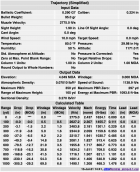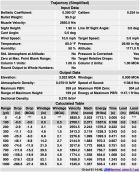Ned, or others, have you guys seen any groups size difference between CC BR-4 primers in a .223 and CCI 41’s? I think I’ve seen better .308 groups and definitely lower SD’s with the BR 4 primers.
I’m looking to shoot club TR with a .223 and won’t be loading so warm that 41’s would necessarily be advisable.
A second question is whether anyone has noticed the .223 with heavies to be be particularly sensitive to warm loads in terms of groups really opening up, despite brass and primers appearing to remain acceptable.
In my open guns brass life suffers a lot more and a lot sooner at the high end of charges than group size seems to, and I’m wondering if that’s not really as true in a .223, where I’m seeing warm charges shoot mediocre groups as 200.
David - I have almost exclusively used Fed 205s. Last fall before the reloading supply madness reached its full potential, I bought some CCI 450s and BR4s, just to have them on hand as an alternative in the event the Fed 205s at some point don't provide the desired results. I have not tested them with any .223 loads as yet. However, I did test them with a .308 Win/Varget/200.20X load and the ES/SD values increased markedly with both CCI primers as compared to the Fed 205s. As with any load workup, I think you can only know how a given primer might work by testing it.
It is possible you may be dealing with more than one issue here. In the past, I always targeted the 2840-2850 fps velocity range with 90 VLDs over H4895 with a 30" barrel. In my hands, they just flat out shoot in that velocity range. However, seating depth is the
real key to getting them to shoot. I have found with multiple 30" Bartlein 5R barrels that the 90s like to tune in two different seating depth regions. One is with them seated approximately .004" and .007"
into the lands. The other is with them seated to approximately .021" and farther
off the lands. For me, the seating depth window
off the lands has always been the wider of the two, and you don't have to deal with potential pressure issues that might be caused by seating them
into the lands. I always felt the choice to seat the 90s in the region of at approximately .021" off the lands [actual seating depth subject to testing] was a no-brainer. However, that seating depth region doesn't seem to work for everyone. Some have, by necessity, found that seating them a short distance
into the lands was the only place they could get them to tune in respectably. Only the rifle can tell you.
The 2840-2850 fps load is predicted by QuickLoad to be at least a couple thousand psi above SAAMI max, and brass life obviously suffers as a result. After tiring of replacing Lapua brass every 3-4 firings, I decided to slow the load down a bit, to the ~2820 fps range in the same rifle setup, just to be a bit easier on the brass and possibly mitigate any future jacket failure issues (FWIW - I've never yet lost a 90 VLD jacket in a 30"
7.0-twist 0.218"/0.224" 5R barrel). To my surprise, it tuned in every bit as well at that velocity as did the faster loads I had previously been running. I may have just caught the lower edge of the same node, but it worked surprisingly well. Again, seating depth was the real key to shrinking the groups. After that experience, it would not surprise me if someone could get the 90s to tune in at almost any velocity they wanted with the proper charge weight and seating depth testing regimen, barrel harmonics and optimal tuning theory be damned. As I mentioned previously, I know a few shooters that run the 90 VLDs at ~2775 fps from the same rifle setup and they shoot extraordinarily well. In fact, I have lately been fire-forming my .223 Rem brass on the first firing using that same slower load and it shoots stupidly well.
The bottom line is that it is not uncommon for loads at the high end of the usable pressure range to sometimes start behaving erratically. The real key to that is to never let the pressure get that high. In the small .223 Rem case, temperature-induced increase in velocity can be a problem, even with relatively temperature-resistant powders like H4895 or Varget. A 30 degree increase in temperature and the resultant velocity increase may easily be enough to cause a given tuned load to go out of tune, which is not at all the same thing as saying the load could not have been tuned at the higher [increased] velocity to start with, as long as the brass would withstand it. What I'm getting at is that in the small .223 Rem case,
everything matters. Find a load that works well and gives acceptable ES/SD and precision within a given temperature range, then do some testing in temperatures
outside that range so you know exactly how much the charge weight needs to be adjusted to keep you within a certain velocity/pressure window. If you need to adjust the load for various temperature changes on different days, or even between morning and afternoon matches in some locals where the daily temperature swing is large, so be it.
When you do the initial load workup, test a few different primers and see whether one primer gives reproducibly lower ES/SD values together with acceptable precision. If so, use that primer. I would not try to select a primer on the basis of its perceived brisance and expected cooler or warmer temps. The primer brisance can be critical for producing acceptably low ES/SD, but you really want to adjust the
charge weight to account for temperature changes sufficient to throw a load out of tune, not change the primer. I'm not saying different primers can't give different velocities based on their brisance with the same charge weight, they can. I'm just saying if high temps and pressure may be an issue, I'd start by determining velocity over an appropriate temperature range and then adjusting the charge weight for the temperature accordingly. I assume the mechanism(s) by which switching primers can have such a dramatic effect on ES/SD and precision are very complex. At least, I have never personally heard any detailed mechanism described for primer brisance and its effect on precision and ES/SD that accounts for all behaviors people observed. It's far easier to simply accept that one primer may work better with a certain load than another, and then test empirically to determine which one to use, rather than to try to predict how a given primer might behave under certain conditions. In contrast, we know in advance exactly what increasing or decreasing charge weight within a relatively narrow range will do to velocity. So my suggestion would be to find (and use) the primer that gives you the best ES/SD and precision within the velocity range of a tuned load with the powder/bullet you've selected. If you need to account for pressure/velocity changes due to temperature variance, do it with charge weight.
The final issue I would touch on is that of the ultimate velocity of a tuned load. The difference in external ballistics (windage) between the slower ~2775 fps 90 VLD load I mentioned above and the brass-killing one running at 2850 fps is relatively small. As shown in the outputs below from JBM Ballistics, the difference in predicted windage at 600 yd is 0.9" (~0.1 MOA), and at 1000 yd is 3" (~0.2 MOA). Granted, these differences are not
zero. Nonetheless, the fact is that increased velocity has a relatively small impact on reducing wind deflection as compared to increasing the BC of the bullet. At 600 yd, I would argue the difference in windage between these two loads is so small that most shooters would find it very difficult to ever tell the difference. My point is simply that wringing the most possible velocity out of a given load is all well and good. I have done it plenty of times, myself. But in the grand scheme of things, sacrificing a little velocity to obtain a very precise and more stable load/tune can sometimes be the better choice.












